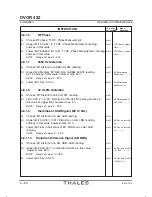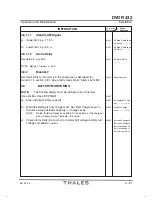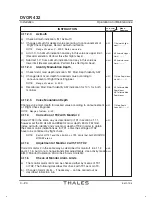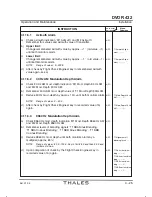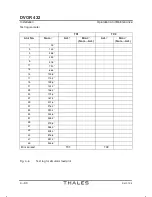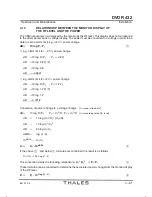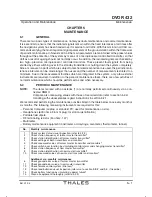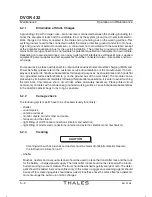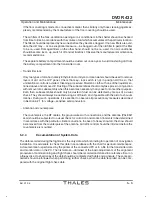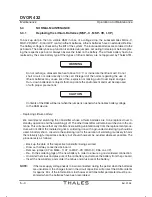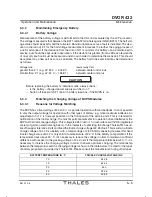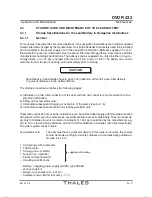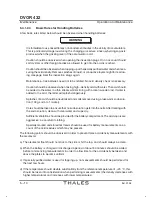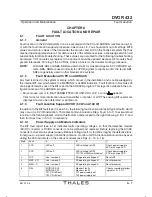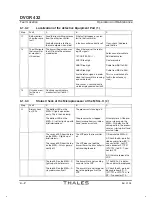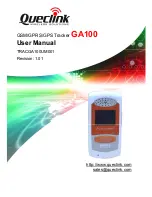
DVOR 432
Maintenance
Operation and Maintenance
5-2
Ed. 01.04
5.2.1
Elimination of Static Charges
A grounding strip with a large cross-sectional area is connected between the shelter grounding terĆ
minal, the equipment racks and the worktable to act as the system ground and to eliminate electroĆ
static charges. It is firmly connected to the table and a grounding bus on the working surface. This
systemground should not be connected to either the mains protective ground conductor or to housĆ
ings and grounds of external consumers, i.e. consumers not associated with the worktable, except
at the potential equalization bus for the overall installation. The protective ground wire offered with
mains cable or plug connections is not suitable for potential equalization of equipment on a worktable.
Depending on local circumstances, it can carry quite high RF interference voltages. Mains-supplied
equipment, power supplies and test equipment should be connected via two-wire cables and two-
pin plugs.
For measures to be taken with respect to components sensitive to electricostatic charging (MOS, Low
Power Schottky) please refer to the customer service documentation of the manufacturer. If an emĆ
ployee is required to handle subassemblies for transport purposes, he should place both hands flat
on a grounded surface beforehand (e.g. on the ground bus of the work table). The module can be
picked up by its insulator immediately following this potential equalization. It is safer to avoid touching
the terminals. Only remove short-circuit links where absolutely necessary. Place printed circuit
boards only on tables with a conductive, grounded working surface. Leave individual subassemblies
in the antistatic plastic bags for as long as possible.
5.2.2
Damage check
The following systemparts have to be checked visually for entirety:
- shelter
- counterpoise
- antenna radomes
- monitor dipole, monitor mast and cable
- fence around the station
- tight fitting of all RF cable connections (internal and external).
- tight fitting of all screwed connections (internal and external, electrical and mechanical).
5.2.3
Cleaning
CAUTION
Cleaning aids, such as brushes and dusters, must be made of antistatic material. See also
the instructions in Section 5.2.1.
- Shelter
Brushes, dusters and a vacuumcleaner should be used to clean the transmitter rack and the rack
for the battery-charged power supply. The transmitter room should not be cleaned with a broom,
but rather using a vacuumcleaner. The floor should be washed regularly every 6 month. The deterĆ
gent should be added in small quantities only to the water; no aggressive cleaning agents should
be used. Floor cleaning agents should be avoided, since these have the same effect as a dielectric
and encourage the build-up of static charges.
Summary of Contents for DVOR 432
Page 2: ......
Page 4: ......
Page 16: ...DVOR 432 Table of Contents Operation and Maintenance X Ed 01 04 ...
Page 38: ...DVOR 432 General Information Operation and Maintenance 1 6 Ed 01 04 ...
Page 40: ...DVOR 432 General Information Operation and Maintenance 1 8 Ed 01 04 ...
Page 46: ......
Page 66: ...DVOR 432 Installation Operation and Maintenance 2 24 Ed 01 04 ...
Page 74: ......
Page 136: ...DVOR 432 Installation Operation and Maintenance 4 32 Ed 01 04 ...
Page 172: ...DVOR 432 Repairs Operation and Maintenance 6 22 Ed 01 04 ...
Page 186: ...DVOR 432 Repairs Operation and Maintenance 6 36 Ed 01 04 ...
Page 192: ...DVOR 432 Installation Operation and Maintenance Annex Nextfield AN 4 Ed 01 04 ...
Page 194: ......
Page 196: ...DVOR 432 General Operation and Maintenance Annex Nextfield L 2 Ed 01 04 ...
Page 204: ...DVOR 432 Alignment Procedure Operation and Maintenance Annex Nextfield AN 14 Ed 01 04 ...
Page 234: ...DVOR 432 Maintenance Operation and Maintenance Annex Nextfield AN 44 Ed 01 04 ...

